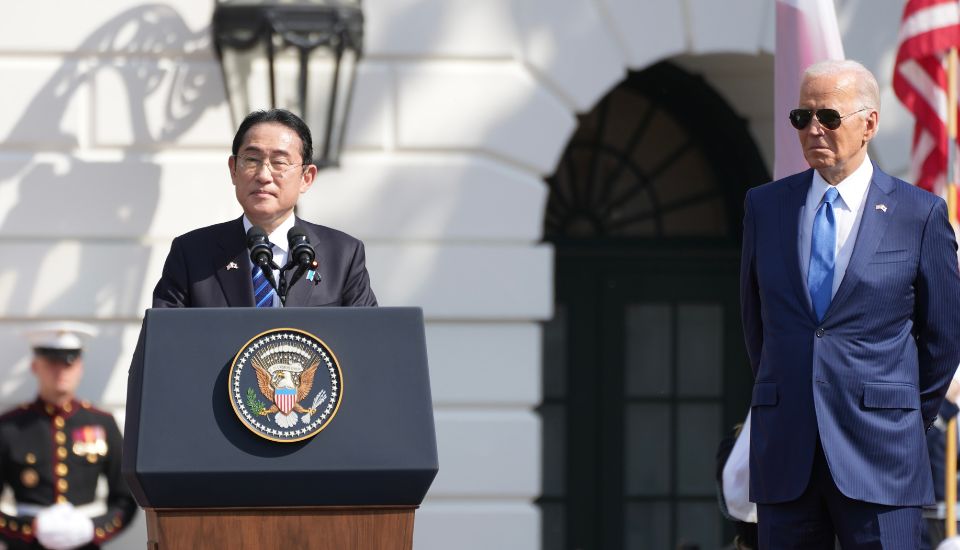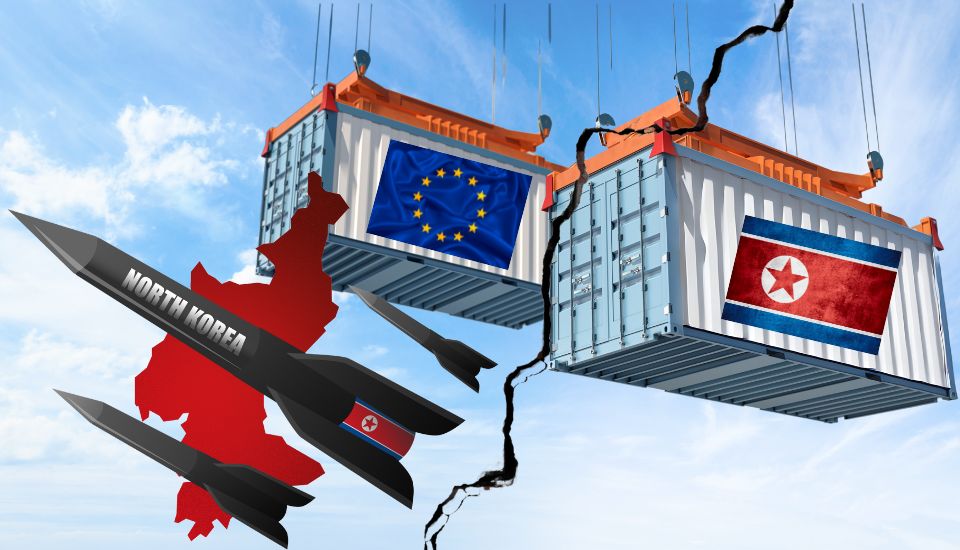
The Cornerstone: Strategic Lessons for ROK from the U.S.-Japan Summit
Commentary | April 22, 2024
Yang Gyu KIM
Principal Researcher, EAI
Lecturer, Department of Political Science and International Relations, Seoul National University
Yang Gyu Kim, Principal Researcher at EAI, examines the strengthening of the U.S.-Japan alliance following the recent summit and provides insights into future foreign policy directions for South Korea. Kim emphasizes that Japan's prospective participation in AUKUS Pillar 2 and its key position in numerous U.S.-led mini- and multilateral cooperation frameworks stem from the Japanese government's active endeavors and investments in aligning its China strategy with that of the U.S. In this context, Kim suggests that South Korea should enhance its cooperation with the U.S. to meet the goals of Defense Innovation 4.0, while also proactively responding to potential opposition from China and the challenges posed by North Korea's New Cold War diplomacy.
|
Available Downloads |
Japanese Prime Minister Kishida Fumio made an official visit[1] to Washington D.C. from April 9 to 14, participating in a state dinner, the US-Japan Summit, the US-Japan-Philippines Summit, and delivering an address at a Joint Meeting of the U.S. Congress. This visit marked the first by a Japanese Prime Minister in nine years since Shinzo Abe’s 2015 visit. It was also the fifth official or state visit during the Biden administration, preceded by visits from the leaders of India, Australia, South Korea, and France. Prior to the summit, potential agenda items including the modernization of the U.S. Forces Japan (USFJ) command and control structure and Japan’s participation in AUKUS Pillar 2 were spotlighted during a media interview with Prime Minister Kishida and U.S. Deputy Secretary of State Kurt Campbell, drawing considerable attention.
This briefing (1) assesses the outcomes of the summit, officially summarized by both governments as “Global Partners for the Future,” (2) analyzes the implications for Japan’s position within the U.S. alliance framework in the Indo-Pacific region, and (3) investigates its implication for South Korea’s security strategy and its policies towards China and Democratic People's Republic of Korea (DPRK).
I. U.S.-Japan Summit Recap: Key Agendas and Importance
Kishida noted that this summit came at a “historic turning point,” necessitating a significant enhancement in Japan’s defense posture (Montgomery, Ogura, and McCarthy 4/7/2024). The summit occurs at a crucial juncture, highlighting the growing significance of the US-Japan alliance in the face of escalating global tensions. These tensions are fueled by events such as the strengthening of DPRK-Russia ties amid the ongoing Ukraine conflict, an Israeli strike on Iran’s consulate in Syria and subsequent Iranian retaliation, China’s use of a water cannon against a Philippine boat in the South China Sea, and the increasing missile threats and aggressive nuclear posture of the DPRK.
This was also a significant diplomatic event amid a critical period in Japanese domestic politics. The Liberal Democratic Party is grappling with a political crisis stemming from a funding scandal, which has caused its approval ratings to plummet to between 10-20%. For Kishida, securing a diplomatic victory became essential. Equally important was Japan’s effort to cement US-Japan relations in a way that would withstand potential shifts in the U.S. political landscape, particularly if Donald Trump were to be re-elected in November. Japan’s concerns about this scenario are encapsulated in the newly coined phrase “moshitora (もしトラ),” which translates to, “What if Trump [becomes POTUS again]?”
On April 10, the U.S. and Japan issued a Joint Leaders’ Statement announcing that their leaders had discussed strategic initiatives aimed at maintaining a free and open international order based on the rule of law and addressing 21st-century challenges (The White House 2024b). These initiatives include strengthening defense and security cooperation, exploring new frontiers in space, driving technological innovation, bolstering economic security, accelerating climate action, enhancing global diplomacy and development, and strengthening people-to-people ties. Among these, the most immediate impact on the regional dynamics in the Indo-Pacific region could be the advancement of defense and security cooperation (The White House 2024a). Notable changes to watch for are outlined below.
First, the initiative to “upgrade alliance command and control” aims to bilaterally enhance command and control frameworks to allow for seamless integration of operations and capabilities, ensuring greater interoperability and planning between the two nations. Second, the United States and Japan plan to explore advanced capabilities under AUKUS Pillar 2, leveraging Japan’s strengths and its close defense partnerships with member countries. Third, they aim to strengthen regional networked security by collaborating with Australia on a networked air defense architecture. Fourth, the two countries are looking to deepen US-Japan defense industry cooperation by creating an alliance defense production capacity and convening a Forum on Defense Industrial Cooperation, Acquisition, and Sustainment (DICAS) to pinpoint priority areas for collaboration, including co-development, co-production, and co-sustainment. Fifth, they are committed to enhancing regional maintenance and repair capabilities, including exploring options for repairing forward-deployed U.S. Navy ships and servicing engines of U.S. Air Force aircraft stationed in Japan, such as fourth-generation fighters. Sixth, they plan to bolster Japan’s stand-off defense and counter-hypersonic capabilities through the cooperative development of the Glide Phase Interceptor to address hypersonic threats. Finally, the U.S. and Japan will improve trilateral intelligence, reconnaissance, and surveillance (ISR) operational coordination with Australia and conduct trilateral exercises with South Korea.
II. Upgrading the U.S.-Japan Alliance: The Cornerstone of U.S. Indo-Pacific Strategy
Given the security cooperation initiatives emphasized in the Joint Statement, what would be the most significant change to the U.S. alliance operating system in the Indo-Pacific region? While the level of actual execution of these programs would be more important than the content of the negotiation itself, just based on the summit outcome, it is evident that the U.S.-Japan alliance has become the cornerstone of U.S. military strategy as part of its Indo-Pacific Strategy.
First and foremost, Japan’s inclusion in AUKUS Pillar 2 as the first non-Western ally of the U.S. presents a significant opportunity to enhance its military capabilities and solidify its position within the alliance system. While AUKUS Pillar 1, which focuses on delivering nuclear-powered attack submarines capabilities to Australia, is more widely recognized, Pillar 2 could be more impactful in the long term. Pillar 2 deals with key future battlefield technologies, including unmanned underwater vehicles, quantum technology, artificial intelligence and autonomous weapon systems, cyber warfare capabilities, hypersonic and counter-hypersonic missiles, and electronic warfare.
Integrated deterrence, a core concept of the US’s new defense strategy, emphasizes a seamless integration of U.S. and allied capabilities, highlighting the importance of investments in interoperability. Furthermore, Washington’s strategy to de-risk against China hinges on countering China’s advancements in military applications of cutting-edge technology. Thus, Pillar 2 holds substantial “game-winning potential” in the US-China strategic competition (Christianson, Monaghan, and Cooke 2023). US-Japan cooperation in new weapons production, maintenance, and repair will also be strengthened by this partnership. Consequently, Japan’s entry into what was previously an exclusive Anglo-American network indicates a significant elevation of Japan’s role as the cornerstone of U.S. alliance network in the Indo-Pacific region.
Secondly, if implemented, the modernization of the command and control systems of the U.S.-Japan Joint Operations Command (JOC) is poised to significantly bolster the USFJ as a military hub with the authority to conduct independent operations in the Indo-Pacific. USFJ, which includes approximately 54,000 U.S. personnel from the Navy, Marine Corps, Air Force, and Army, hosts the USS Ronald Reagan—the only forward-deployed U.S. Navy aircraft carrier—at its port in Yokosuka (O’Dell 2023). Historically, the limited operational authority of the three-star USFJ commander, who is under the command of the United States Indo-Pacific Command (USINDOPACOM) headquartered in Hawaii, has restricted USFJ to serving merely as a platform for regional military operations (Johnstone and Schoff 2024).
USFJ is unlikely to achieve a command and control level comparable to the Combined Forces Command (CFC) of the U.S. Forces in Korea (USFK), primarily because the roles and objectives of the Japan Self-Defense Forces (JSDF) are constrained by the Peace Constitution and there is public resistance to transferring operational command to U.S. forces (Takahashi 2024). Nevertheless, significant strides towards modernizing command and control were agreed upon at this summit and during the US-Japan Security Consultative Committee (SCC) meeting in January 2023. As a result, an enhanced joint command and control framework is expected to emerge soon.
Thirdly, the role of the US-Japan alliance as the cornerstone of the U.S. Indo-Pacific Strategy is being reinforced. Pentagon Press Secretary Air Force Major General Patrick Ryder highlighted that the US’s ties with Japan “form the core of the alliance and are the cornerstone of regional peace and security in the Indo-Pacific” (U.S. Department of State 2024). Indeed, the Joint Statement from the US-Japan summit positions Japan at the forefront of various mini- and multilateral alliance cooperation, such as those involving US-Japan-Australia, US-ROK-Japan, and US-Japan-Philippines. These partnerships focus on creating regional networks for information sharing on missile defense, intelligence surveillance, and conducting joint military exercises.
Kishida’s address to the Joint Meeting of the U.S. Congress epitomizes the reason for Japan’s rising status in the U.S. alliance framework. In his speech, Kishida acknowledged the “loneliness and exhaustion” the U.S. has faced in upholding the international order largely on its own, affirming that the US’s leadership is “indispensable.” He emphasized that the U.S.is “not alone,” referring to Japan as the “United States’ closest friend, tomodachi (ともだち)” (MOFA Japan 2024). This statement affirmed that Tokyo shares the same strategic objectives and directions with Washington, particularly in relation to China and Russia.
III. ROK’s Way Forward: Advancing Defense Innovation and Rethinking China & DPRK Policy
Japan’s role as a pivotal player in the U.S. alliance operating system in the Indo-Pacific region is set to grow. What steps, then, should South Korea take?
In short, for the successful execution of Defense Innovation 4.0, South Korea should also consider joining AUKUS Pillar 2. The Defense Innovation 4.0 initiative aims to build a formidable military force based on AI science and technology, with a level of commitment comparable to a “second establishment of the army” (MND 2023). Its five implementation focuses and 16 tasks range from significantly enhancing capabilities to counter North Korea’s nuclear weapons and missiles, to leading the development of military strategies and operational concepts, and securing AI-based core advanced combat capabilities. These endeavors, which ultimately aim to bolster the all-domain combined operational capabilities of strategic assets, align with the technology cooperation initiatives outlined in AUKUS Pillar 2 (Ryoo 2023). Although the US-ROK Next Generation Critical and Emerging Technologies Dialogue initiated in December 2023 includes cooperation on AI, quantum science, and semiconductors, its focus remains on economic security rather than military applications of advanced science technologies. Given that AUKUS is setting standard for enhancing the interoperability of the U.S. alliance network, South Korea needs to take a proactive role in discussions with the U.S. about joining Pillar 2.
However, both careful consideration and the establishment of an appropriate response to the potential costs are crucial. Unlike QUAD, AUKUS explicitly focuses on countering China as a strategic objective, which will undoubtedly elicit opposition from China if ROK pursues membership. Therefore, Seoul must primarily justify its participation in AUKUS Pillar 2 by emphasizing the need to strengthen deterrence against the escalating nuclear and missile threats from DPRK. Additionally, given that the enhanced U.S.-Japan alliance is fundamentally aligned against China, South Korea must also critically assess the direction of its China policy in the interest of long-term national security. Now is the time for South Korea to devise a tailored de-risking strategy amidst the US-China strategic rivalry, considering its broader strategic implications.
Moreover, South Korea must prepare for North Korea’s opposition and the potential increase in tensions on the Peninsula. Collaborating with the U.S. to bolster national defense with advanced technology supports the primary goal of Defense Innovation 4.0: significantly enhancing counter-DPRK capabilities. However, the development of high-yield and high-precision attack capabilities, central to the Korea Massive Punishment and Retaliation (KMPR) campaign, not only serves as a deterrent but also as a potential means for preemptive action aimed at ending the North Korean regime. This enhancement of South Korea’s retaliatory capabilities could lead to increased North Korean sense of insecurity about regime stability, potentially intensifying the security dilemma on the Korean Peninsula and escalating the asymmetric arms race between South Korean conventional forces and North Korean nuclear forces. Consequently, it is critical for South Korea to establish clear doctrines and principles emphasizing that its capacity-building based on advanced technology is solely focused on enhancing defensive posture. For instance, South Korea should clarify that it will not initiate the KMPR campaign unless North Korea starts a total war or uses nuclear weapons.
This intersection of issues could create new challenges. For example, in response to South Korea joining AUKUS Pillar 2, China might ease sanctions on North Korea and bolster DPRK-China-Russia cooperation to pressure the ROK-US-Japan alliance and induce South Korea’s detachment. Concurrently, North Korea, employing its “New Cold War” diplomatic strategy, might actively seek Chinese support to pressure South Korea or aim to gain more by aligning with Chinese actions. In this context, South Korea’s efforts to advance defense innovation through the AUKUS framework must proceed in tandem with consistent messaging to China and North Korea about its defensive intentions and a pursuit of dialogue with DPRK. The recent US-Japan summit also highlighted the importance of diplomacy and engagement based on principles and advocated for dialogue with DPRK without preconditions, calling for the immediate resolution of the abduction issue.
Finally, it’s important to recognize that the recent strengthening of the US-Japan alliance stems from the Japanese government’s proactive efforts and investments. Japan has significantly increased its defense spending to 2% of its Gross Domestic Product (GDP), secured long-range striking capabilities through the acquisition of Tomahawk Land Attack Missiles, and established the JSDF Joint Operations Command. In parallel, as South Korea seeks enhanced security cooperation with the U.S. though participating in AUKUS, it should also take independent initiatives to boost its international stature and demonstrate its commitment. Expanding humanitarian aid in Ukraine and the Middle East could be instrumental in enhancing South Korea’s role in the global community and strengthening its position as a Global Pivotal State.
References
Christianson, John, Sean Monaghan, and Di Cooke. 2023. “AUKUS Pillar Two: Advancing the Capabilities of the United States, United Kingdom, and Australia.” CSIS. July 10. https://www.csis.org/analysis/aukus-pillar-two-advancing-capabilities-united-states-united-kingdom-and-australia (Accessed: April 16, 2024)
CSIS. 2024. “Previewing the Japanese Official Visit and Trilateral Leaders’ Summit.” CSIS Press Briefing. April 2. https://www.csis.org/analysis/previewing-japanese-official-visit-and-trilateral-leaders-summit (Accessed: April 16, 2024)
Johnstone, Christopher B. and Jimm Schoff. 2024. “A Vital Next Stop for U.S.-Japan Alliance: Command and Control Modernization.” CSIS. February 1. https://www.csis.org/analysis/vital-next-step-us-japan-alliance-command-and-control-modernization. (Accessed: April 16, 2024)
Ministry of Foreign Affairs of Japan (MOFA Japan). 2024. “Address by Prime Minister KISHIDA Fumio at a Joint Meeting of the United States Congress (‘For the Future: Our Global Partnership’).” April 11. https://www.mofa.go.jp/pageite_000001_00262.html (Accessed: April 16, 2024)
Ministry of National Defense (MND). 2023. “Ministry of Defense Announces ‘Basic Plan on Defense Innovation 4.0’… Nurturing Robust Armed Forces Based on AI Science and Technology (Translated).” Briefing Room. March 7. https://www.korea.kr/multi/visualNewsView.do?newsId=148913452 (Accessed: April 16, 2024)
Montgomery, Hanako, Junko Ogura, and Simone McCarthy. 2024. “Japan’s Kishida warns world at ‘historic turning point’ as he touts U.S.alliance ahead of Biden summit.” CNN. April 7. https://edition.cnn.com/2024/04/07/asia/japan-kishida-us-defense-intl-hnk/index.html (Accessed: April 16, 2024)
O’Dell, Hope. 2023. “The U.S.is sending more troops to the Middle East. Where in the world are U.S.military deployed?.” Bluemarble. October 25. https://globalaffairs.org/bluemarble/us-sending-more-troops-middle-east-where-world-are-us-military-deployed(Accessed: April 16, 2024)
Ryoo, Moo Bong. 2023. “「Defense Innovation 4.0」 to build Robust ROK Armed Forces of AI Science and Technology. ROK Angle: Korea’s Defence Policy 261: 1-4.
Takahashi, Kosuke. “Deeper and Wider Defense Integration Tops Japan-US Summit Agenda.” The Diplomat. April 12. https://thediplomat.com/2024/04/deeper-and-wider-defense-integration-tops-japan-us-summit-agenda/ (Accessed: April 16, 2024)
The White House. 2022. “National Security Strategy.” October 12. https://www.whitehouse.gov/wp-content/uploads/2022/10/Biden-Harris-Administrations-National-Security-Strategy-10.2022.pdf (Accessed: April 16, 2024)
The White House. 2024a. “FACT SHEET: Japan Official Visit with State Dinner to the United States.” Briefing Room. April 10. https://www.whitehouse.gov/briefing-room/statements-releases/2024/04/10/fact-sheet-japan-official-visit-with-state-dinner-to-the-united-states/ (Accessed: April 16, 2024)
The White House. 2024b. “United States-Japan Joint Leaders’ Statement.” Briefing Room. April 10. https://www.whitehouse.gov/briefing-room/statements-releases/2024/04/10/united-states-japan-joint-leaders-statement/ (Accessed: April 16, 2024)
U.S. Department of Defense. 2024. “Pentagon Press Secretary Air Force Maj. Gen. Pat Ryder Holds a Press Briefing.” April 11. https://www.defense.gov/News/Transcripts/ Transcript/Article/3739158/pentagon-press-secretary-air-force-maj-gen-pat-ryder-holds-a-press-briefing/ (Accessed: April 16, 2024)
[1]This visit was classified as “official” since the Japanese Prime Minister serves as the head of government rather than the head of state. Nevertheless, the protocol and treatment provided were equivalent to those of President Yoon Suk Yeol’s state visit last April.
■ Yang Gyu KIM is the Executive Director (Principal Researcher) at EAI and a Lecturer in the Department of Political Science and International Relations at Seoul National University.
■ Typeset by: Jisoo Park, Research Associate
For inquiries: 02 2277 1683 (ext. 208) | jspark@eai.or.kr
Security and External Relations

Strategic Crossroads: ROK's Response to DPRK's Diplomatic Moves in the Emerging New Cold War Era
Chaesung CHUN | 15.April.2024

Evolution of Europe-North Korea Relations: From Active Engagement to Partial Rupture (2/2)
Antoine Bondaz | 25.March.2024

Deciphering North Korea’s Policy Shift: Annihilation of ROK vs. End of Kim Regime
Young-Sun HA | 11.March.2024
LIST